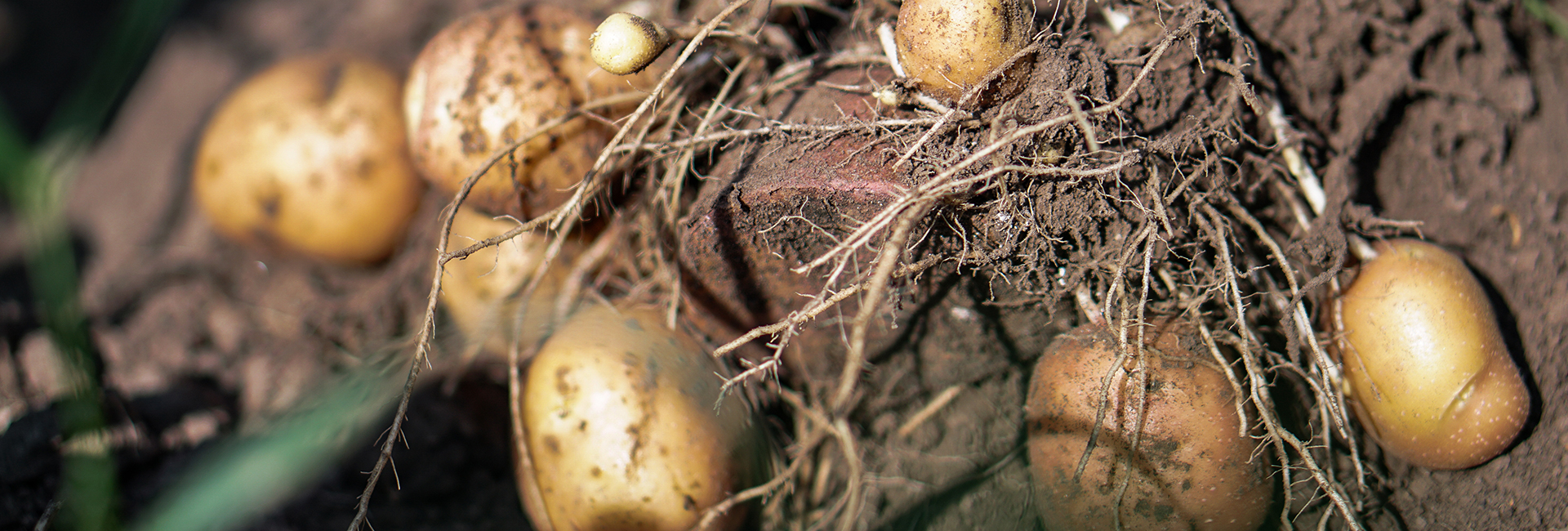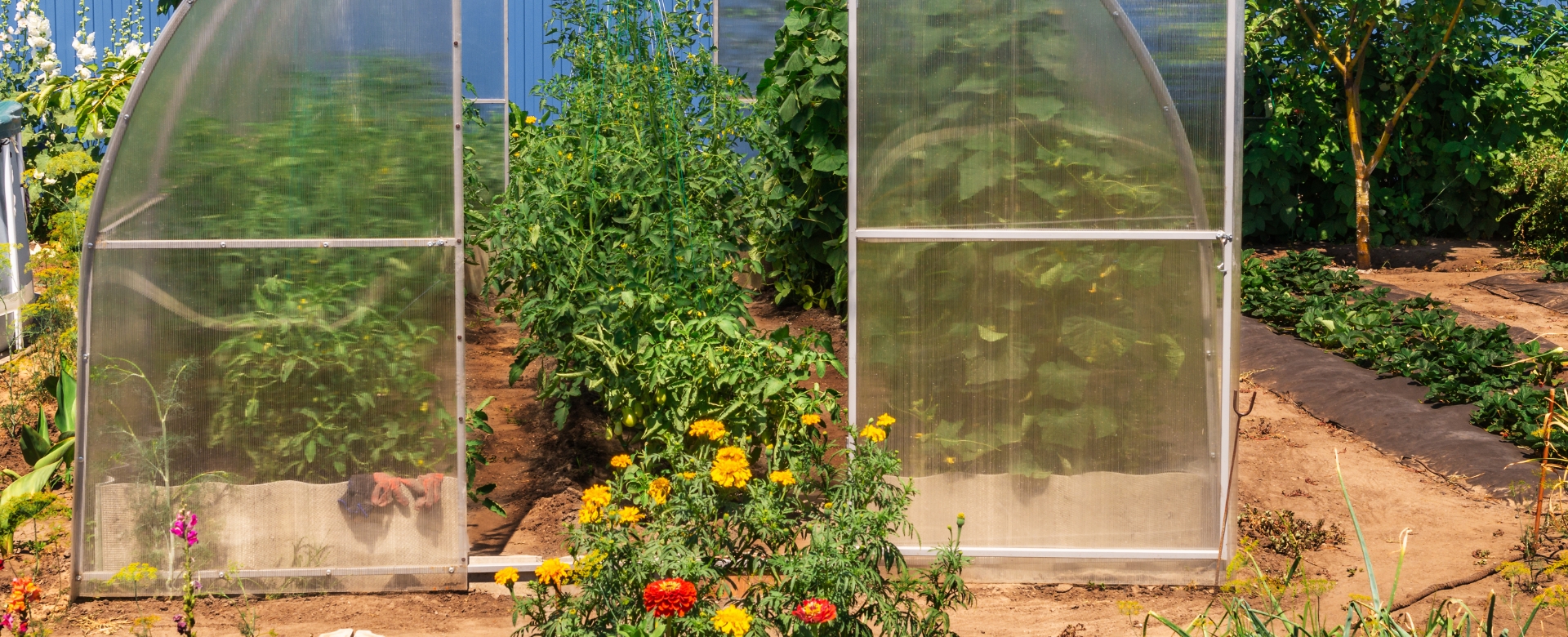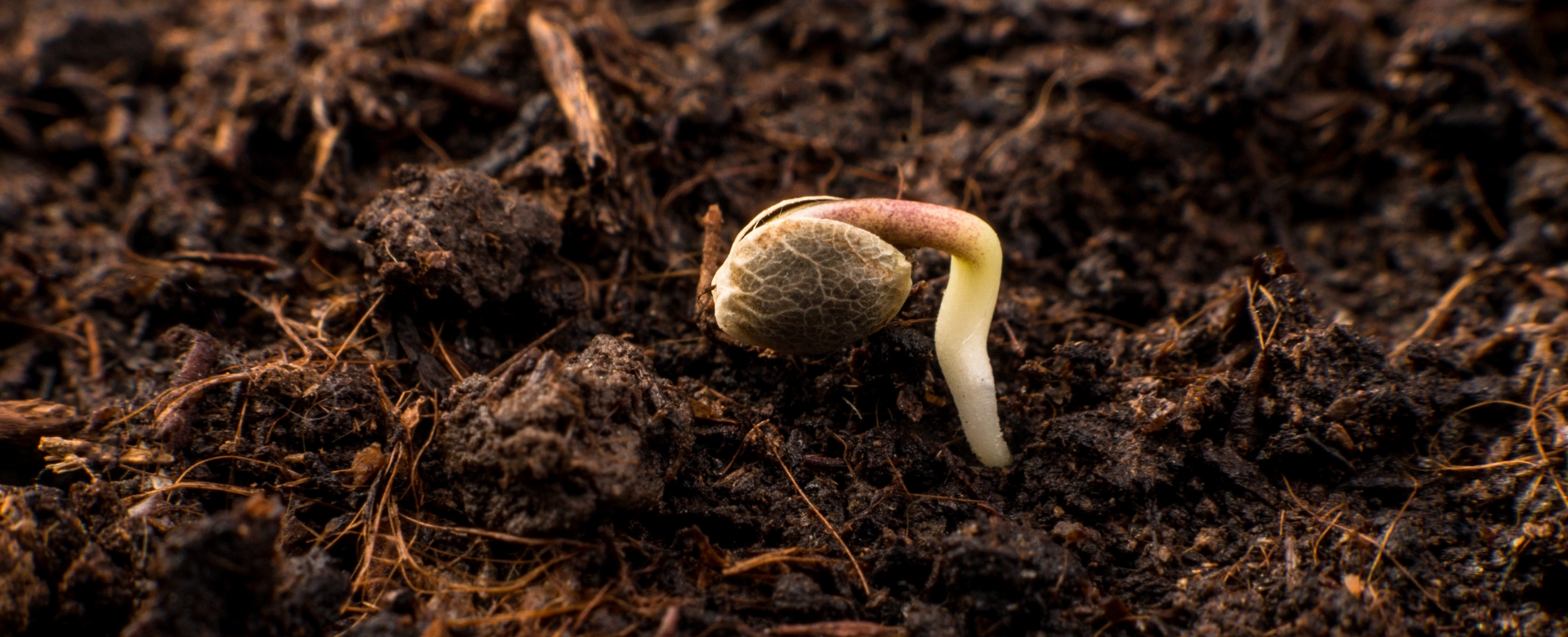Tomato blossom end rot is one of the most common and frustrating problems that gardeners face.
Not sure if you’ve experienced end rot in your tomato crop? One of the telltale signs is your tomatoes will develop brown or blackish spots where the blossom sits on your tomatoes. Over time, these spots grow, ruin the fruit, and greatly diminish your tomato harvest.
Fortunately, many have faced this and there are easy tomato blossom end rot treatments you can use. They start with the soil. Need some help?
This guide to tomato blossom end rot will help will show you:
- What tomato blossom end rot is
- How to diagnose it
- Potential causes
- How to treat blossom end rot
What Is Tomato Blossom End Rot?
Blossom end rot is a common tomato disease that’s caused by a calcium deficiency in the tomato plant. The disease shows brownish or black spots on the bottom of the fruit and the fruit may be deformed.
Blossom end rot is caused due to calcium deficiency in the tomato plant. Soil calcium can be depleted for many reasons, from overwatering to extreme temperatures, poor soil quality or too alkaline or acidic soil.
Unfortunately, you can’t treat infected fruits. However, you can treat the plant and amend the soil. Change your watering routine, add calcium to the soil, and use a balanced fertilizer to prevent and treat the issue.
Of note, blossom end rot doesn’t just affect tomatoes. It’s also common in some melons, squash and peppers. Generally, it can be triggered by wet spring / early summer weather, followed by hot, dry conditions.
Symptoms of Blossom End Rot
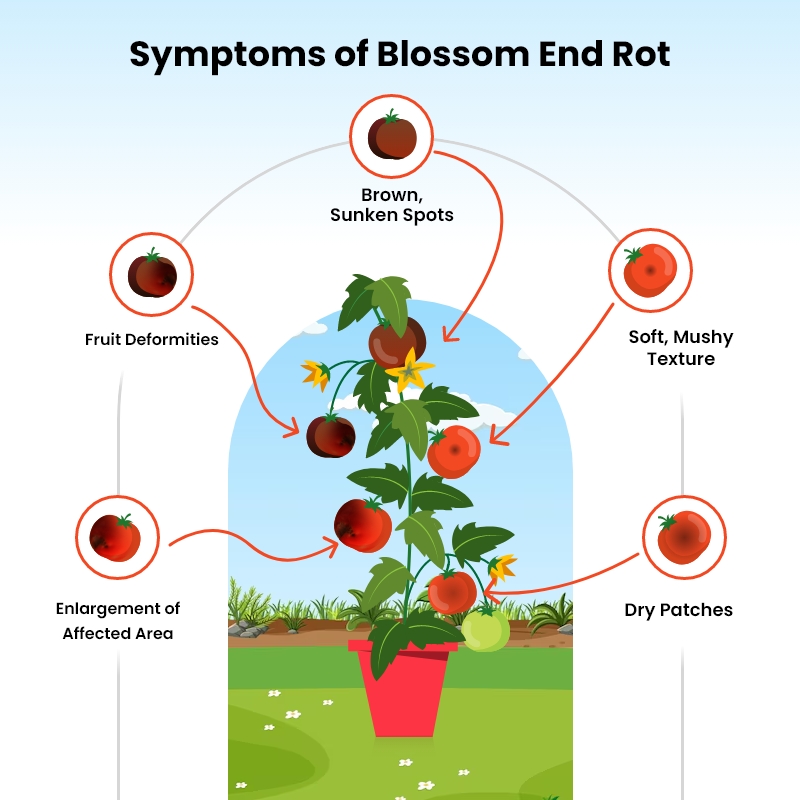
A oily spot at the blossom end of tomato fruits is one of the main symptoms of blossom end rot. This damage first appears when fruits are about half their full size. The damaged areas enlarge and turn leathery and dark brown. These areas start to rot, so you should pick and discard the fruit immediately.
If you suspect you have an issue, look for these common symptoms of blossom end rot in tomatoes:
1. Brown, Sunken Spots
Blossom end rot occurs on both green and ripe fruits. The spots start small but expand as the fruit grows. Initially, they appear as mushy areas that widen and mature into sunken brown leathery spots on the bottom portion of tomatoes.
2. Soft, Mushy Texture
With the progress of blossom end rot, the affected tomatoes start deteriorating and turn soft and mushy. The softening of the tomatoes occurs due to the breakdown of the cell walls and tissue. This results in a loss of firmness and structure in the affected portion of the fruit.
3. Dry Patches
The affected tissues of tomato plants eventually dry, shrink and form leathery patches on tomatoes. These patches form beside the soft, mushy areas or as separate regions on the affected fruit area. The dry patch on tomatoes is a symptom of localized cell death and dehydration of the affected tissues.
4. Enlargement of Affected Area
An area infected with end rot rapidly enlarges, and this spot spreads across a large portion of the fruit’s surface. As the blossom end rot progresses, it covers a significant portion of the fruit, making it unappealing and unfit for consumption.
5. Fruit Deformities
Severe cases of blossom end rot can lead to fruit deformities like irregular shapes or stunted growth. These symptoms indicate a physiological disorder caused by a plant’s calcium deficiency or uptake imbalance. This results in compromised fruit quality.
Causes of Tomato Blossom End Rot
If you don’t know what causes blossom end rot on tomatoes, fret not, as we have listed below the causes of end rot problem.
Calcium Deficiency
If you are using fresh soil to grow tomatoes, it will generally have good calcium levels. On the contrary, if the soil is old and worn out from intensive gardening, it will lack calcium.
Soil calcium deficiency can be due to different environmental factors that prevent the plant from absorbing and transporting the required calcium.
Irregular Watering
Irregular watering is also one of the leading causes of blossom end rot in tomatoes. Longer irrigation intervals may reduce proper water intake. This further leads to plant wilting, which can seriously impact calcium uptake and distribution. When a casual watering routine is followed, and the tomatoes dry out while they are setting fruit, it can cause end rot. Whatever the reason, tomatoes require steady watering.
Root Damage
Cultivating or digging around tomato plants can damage their roots and prevent proper water and calcium intake. Roots damaged during transplanting may struggle to absorb nutrients.
Additionally, root-borne nematodes can damage roots, disturbing their function. It leads to the blossom end rot problem. Therefore, it is essential to keep the roots undisturbed and intact.
Excessive Fertilizer
Over-fertilizing tomato plants with high potassium, nitrogen, or magnesium levels can interfere with their calcium uptake. Excessive use of fertilizers can lead to vigorous foliage growth, which competes with fruit for calcium.
Environmental Factors
Environmental factors like humidity and temperature can affect nutrient uptake and water use of tomato plants. High temperatures and humidity can increase the transpiration rate, leading to water stress and reducing calcium transport.
Additionally, fluctuating temperatures can stress plants and disturb normal nutrient flow. Either heavy rainfall or drought can impact soil moisture balance and nutrient availability in tomato plants.
Genetic Factors
Some tomato varieties are more prone to blossom end rot owing to genetic predispositions. Certain cultivars have a genetic propensity for developing end rot issues under stress conditions. Larger or elongated fruits are more susceptible to blossom end rot.
How to Treat Tomato Blossom End Rot?
Before starting with tomato end blossom rot treatment, remove affected fruits from plants to prevent nutrient drain.
Consistent watering can avoid fluctuations in soil moisture. Apply a foliar spray of calcium chloride or calcium nitrate to provide calcium support to the developing fruits. Carry out a soil test. If the test indicates low calcium levels, amend the soil with gypsum or lime. Also, maintain balanced fertilization practices to avoid nutrient imbalance.
Following are some effective ways to treat blossom end rot tomatoes:
Maintain Watering
You can prevent blossom end rot in tomato plants by maintaining soil moisture. Follow a consistent watering schedule for tomato plants. Water them at ground level and avoid overhead watering.
Tomato plants require regular and deep watering twice a week to keep the soil moist but not wet. The absence of water prevents the plant from absorbing nutrients like calcium. Aim to maintain a constant hydration level until the plants start to flower.
Monitor Soil pH
Monitor soil pH and keep it at the ideal range. This will prevent blossom end rot in your tomato plants. You should perform routine soil tests and, if necessary, change the pH level of the soil. The ideal range of soil pH should be 6.0-6.8.
Provide Proper Calcium
Amend the soil using a fertilizer formulated with calcium sources like lime or gypsum if the soil test shows a deficiency. Use calcium sprays to spray them directly on the leaves and developing fruits, if the blossom root end persists. Make use of solutions like calcium nitrate or calcium chloride for immediate relief.
Avoid Extreme Nitrogen
Excessive nitrogen promotes rapid vegetative growth at the expense of fruit development. Excessive amounts of nitrogen can reduce the ability of calcium absorption for the fruits, leading to blossom end rot. Use fertilizers with a balanced ratio of nitrogen, phosphorus, and potassium (N-P-K). Organic and slow-release fertilizers offer a balanced nutrient supply, reducing the risk of nutrient imbalances.
Monitor Environmental Conditions
Environmental stress like high temperature, fluctuating humidity, and wind, can affect plant water uptake, transpiration rates and impact calcium transport to the fruit. To protect tomato plants from extreme weather conditions, use shade cloth during high temperatures. Ensure proper ventilation in greenhouses to maintain stable humidity levels.
Promote Healthy Roots
Healthy roots play a significant role in adequate water and nutrient uptake. Diseased or damaged roots are less efficient in absorbing calcium, thereby contributing to blossom end rot. To prevent root damage, avoid deep cultivation near plants. Implement healthy gardening practices like crop rotation and use resistant varieties to manage soil-borne pests like nematodes. Besides, regularly inspect tomato plants and treat root diseases promptly.
Mulch
Use organic mulch like grass clippings, peat moss, wood chips, and straw-free weed seeds. Spread a 2-inch thick layer of organic mulch around the base of your plants. This helps retain moisture in the soil, allowing steady growth. Also, mulch doesn’t allow plants to dry out as fast between watering and rain. It helps smother weeds.
Prune Tomatoes Properly
Pruning tomato plants helps improve aeration, light penetration, and nutrient distribution. Remove suckers regularly so that plant’s energy can be directed towards fruit production. Trim lower leaves and thin dense foliage to reduce the risk of diseases. It improves the plant’s overall vigor, supports better calcium uptake, and reduces the likelihood of blossom end rot.
Inspect And Remove Affected Fruits
It is essential to regularly inspect tomato plants to detect blossom end rot problems at an early stage. If left untreated, blossom end rot will keep growing and spreading on the surface of tomatoes.
Remove the damaged tomatoes as soon as you notice symptoms of blossom end rot on them. This helps prevent nutrient drain and redirects the plant’s resources to healthy fruit development. It also helps avoid attracting pests to your garden, minimizes disease spread, and maintains tomato plants’ overall health and productivity.
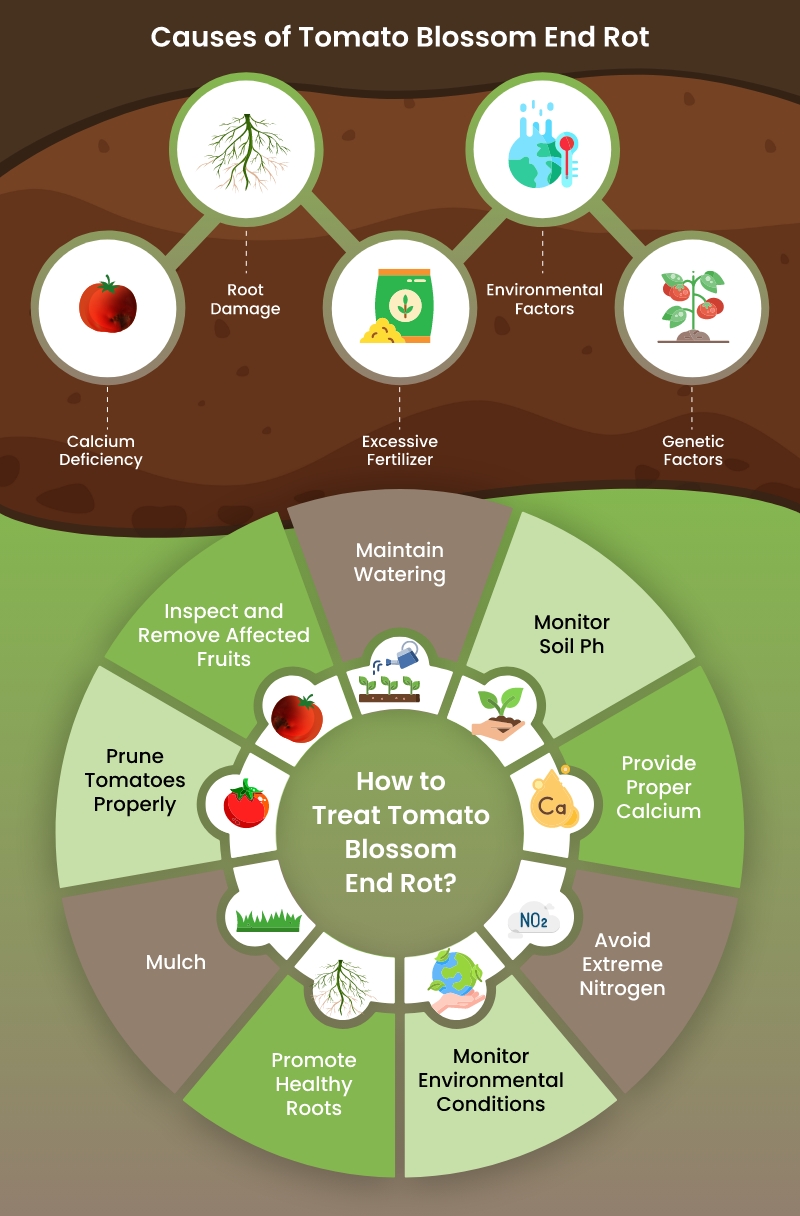
Conclusion
Tomato blossom end rot treatment requires a multifaceted approach that addresses its causes and symptoms. By inspecting and removing affected fruits and maintaining optimal growing conditions, gardeners can reduce the risk of blossom end rot problems and ensure a bountiful harvest of healthy, juicy, and delicious tomatoes. Gardeners can enjoy fresh and juicy tomatoes with proactive care for tomato plants.


